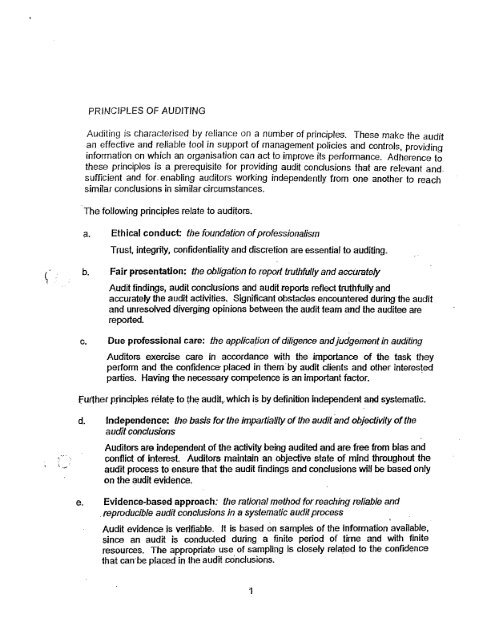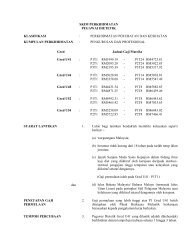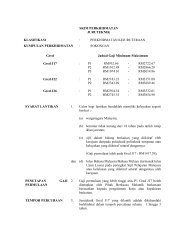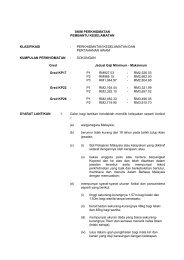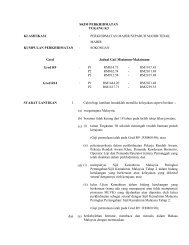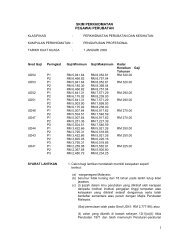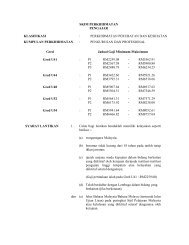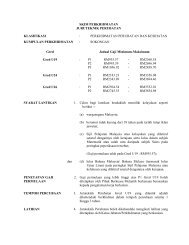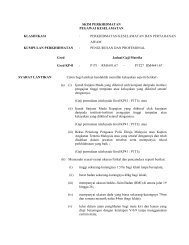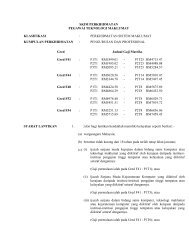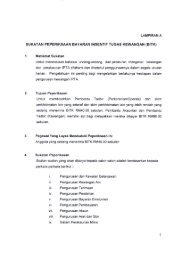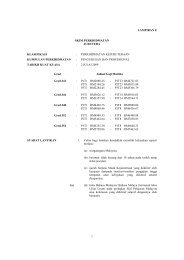PRINCIPLES OF AUDITING Auditing is characterised by reliance on ...
PRINCIPLES OF AUDITING Auditing is characterised by reliance on ...
PRINCIPLES OF AUDITING Auditing is characterised by reliance on ...
- No tags were found...
Create successful ePaper yourself
Turn your PDF publications into a flip-book with our unique Google optimized e-Paper software.
<str<strong>on</strong>g>PRINCIPLES</str<strong>on</strong>g> <str<strong>on</strong>g>OF</str<strong>on</strong>g> <str<strong>on</strong>g>AUDITING</str<strong>on</strong>g><str<strong>on</strong>g>Auditing</str<strong>on</strong>g> <str<strong>on</strong>g>is</str<strong>on</strong>g> character<str<strong>on</strong>g>is</str<strong>on</strong>g>ed <str<strong>on</strong>g>by</str<strong>on</strong>g> <str<strong>on</strong>g>reliance</str<strong>on</strong>g> <strong>on</strong> a number of principles. These make the auditan effective and reliable tool in support of management policies and c<strong>on</strong>trols, providinginformati<strong>on</strong> <strong>on</strong> which an organ<str<strong>on</strong>g>is</str<strong>on</strong>g>ati<strong>on</strong> can act to improve its performance. Adherence tothese principles <str<strong>on</strong>g>is</str<strong>on</strong>g> a prerequ<str<strong>on</strong>g>is</str<strong>on</strong>g>ite for providing audit c<strong>on</strong>clusi<strong>on</strong>s that are relevant and.sufficient and for_ enabling auditors working independently from One another to reachsimilar c<strong>on</strong>clusi<strong>on</strong>s in similar circumstances.The following principles relate to auditors.a. Ethical c<strong>on</strong>duct: the foundati<strong>on</strong> ofprofessi<strong>on</strong>al<str<strong>on</strong>g>is</str<strong>on</strong>g>mTrust, integrity, c<strong>on</strong>fidentiality and d<str<strong>on</strong>g>is</str<strong>on</strong>g>creti<strong>on</strong> are essential to auditing.b. Fair presentati<strong>on</strong>: the obligati<strong>on</strong> to report truthfully and accuratelyAudit findings, audit c<strong>on</strong>clusi<strong>on</strong>s and audit reports reflect truthfully andaccurately the audit activities. Significant obstacles encountered during·the auditand unresolved diverging opini<strong>on</strong>s between the audit team and the auditee arereported.c. Due professi<strong>on</strong>al care: the applica.ti<strong>on</strong> ofdiligence andjudgement in aUdifingAuditors exerc<str<strong>on</strong>g>is</str<strong>on</strong>g>e care in accordance with the jmportance of the task theyperform and the c<strong>on</strong>fidence- placed in them· <str<strong>on</strong>g>by</str<strong>on</strong>g> audit clients and other interestedparties. Having the necessaty competence <str<strong>on</strong>g>is</str<strong>on</strong>g> an important factor.further principles relat~ to th~ audit, which <str<strong>on</strong>g>is</str<strong>on</strong>g> <str<strong>on</strong>g>by</str<strong>on</strong>g> definiti<strong>on</strong> independent and systematic.d. Independence: the bas<str<strong>on</strong>g>is</str<strong>on</strong>g> for the impartiality ofthe audit and objectivity oftheaudit c<strong>on</strong>clusi<strong>on</strong>sAuditors are independent of the activity being audited and are free from bias andc<strong>on</strong>flict of interest. Auditors maintain an objective state of mind throughout theaudit process to ensure that the audit findings and c<strong>on</strong>clusi<strong>on</strong>s will be based <strong>on</strong>ly<strong>on</strong> the ~udit evidence.e. Evidence-based approach: the ratio,?81 method for reaching reliable and.reproducible audit c<strong>on</strong>clusi<strong>on</strong>s in a systematic auditprocessAudit evidence <str<strong>on</strong>g>is</str<strong>on</strong>g> verifiable. It <str<strong>on</strong>g>is</str<strong>on</strong>g> based <strong>on</strong> samples of the informati<strong>on</strong> available,since an audit <str<strong>on</strong>g>is</str<strong>on</strong>g> c<strong>on</strong>ducted during a finite period of time and with finiteresources. The appropriate use of sampling <str<strong>on</strong>g>is</str<strong>on</strong>g> closely rela~ed to the c<strong>on</strong>fidt;!ncethat can-be placed in the audit cOnclusi<strong>on</strong>s.1
CONDUCTING ON-SrTE AUDIT ACTIVITIES1. C<strong>on</strong>ducting the opening meetingAn op~ning meeting sho~ld be held with the auditee's management or, whereappropnate, those resp<strong>on</strong>sIble for the functi<strong>on</strong>s or processes to be audited. Thepurpose of an opening meeting <str<strong>on</strong>g>is</str<strong>on</strong>g> .a. to c<strong>on</strong>firm the audit plan,b. to provide a short summary of how the audit activities will be undertakenc. to c<strong>on</strong>firm communicati<strong>on</strong> channels, and 'd. to provide an opportunity for the auditee to ask questi<strong>on</strong>sPractical help. - Opening the meetingIn many instances, for example internal audits in a small organ<str<strong>on</strong>g>is</str<strong>on</strong>g>ati<strong>on</strong>, the opening'meeting may simply c<strong>on</strong>s<str<strong>on</strong>g>is</str<strong>on</strong>g>t of communicating that an audit <str<strong>on</strong>g>is</str<strong>on</strong>g> being c<strong>on</strong>ducted andexplaining the nature of the audit.For other audit situati<strong>on</strong>s, the meeting should be formal and records of the attendanceshould be kept. The meeting should be chaired <str<strong>on</strong>g>by</str<strong>on</strong>g> the audit team leader, and thefollowing items should be c<strong>on</strong>sidered, as appropriate:a. introducti<strong>on</strong> ot. the participants, including an outline of their roles;b..c<strong>on</strong>firmati<strong>on</strong> of the audit objectives, scope and criteria;c. c<strong>on</strong>firmati<strong>on</strong> of the audit timetable and other relevant arrangements with theaUditee, such as the date and time for the closing meeting, any interim meetingsbetween the audit team and the auditee's management. and any late changes;d. methods. and procedures to be used to c<strong>on</strong>duct the audit, including adv<str<strong>on</strong>g>is</str<strong>on</strong>g>ing theaUditee that the audit evidence will <strong>on</strong>ly be based <strong>on</strong> a ~ample of the informatioravailable ana that therefore there <str<strong>on</strong>g>is</str<strong>on</strong>g> an element of uncertainty in auditing; ~:e. c<strong>on</strong>firmati<strong>on</strong> of formcll communicati<strong>on</strong> channels between the audit team and theauditee;f. c<strong>on</strong>firmati<strong>on</strong> of the language to be used during the aUdi~;g. c<strong>on</strong>firmati<strong>on</strong> that, during the audit, the auditee·will be kept informed of auditprogre&s;h. c<strong>on</strong>firmati<strong>on</strong> that the resources and facilities needed <str<strong>on</strong>g>by</str<strong>on</strong>g> the audit team areavailable;i. c<strong>on</strong>firmati<strong>on</strong> of matters relating to c<strong>on</strong>fidentiality;2
j. c<strong>on</strong>firmati<strong>on</strong> of relevant work safety, emergency and security procedures for theaudit team;k. c<strong>on</strong>firmati<strong>on</strong> of the availability, roles and identities of any guides;I. the method of reporting, including any grading of n<strong>on</strong>c<strong>on</strong>f<strong>on</strong>nities;m. inf<strong>on</strong>nati<strong>on</strong> about c<strong>on</strong>diti<strong>on</strong>s under which the audit may be terminated;n. informati<strong>on</strong> about any appeal system <strong>on</strong> the c<strong>on</strong>duct or c<strong>on</strong>clusi<strong>on</strong>s of the auditPRACTICAL HELP - CONDUCTING INTERVIEWSInterviews are <strong>on</strong>e of the important means of collecting informati<strong>on</strong> and should becarried out in a manner adapted to the situati<strong>on</strong> and the pers<strong>on</strong> interviewed. However,the auditor should c<strong>on</strong>sider the following:)' t a .. interviews should be herd with pers<strong>on</strong>s from appropriate levels and functi<strong>on</strong>sperf<strong>on</strong>ning activities or tasks within the scope of the audit;b. interviews should be c<strong>on</strong>ducted during the normal working hours and, wherepractical, at the n<strong>on</strong>nal workplace of the pers<strong>on</strong> being interviewed;.c. every attempt should be made to put the pers<strong>on</strong> being interviewed at ease priorto and during the interview;d. the reas<strong>on</strong> for the interview and any note taking should be explained;e. interviews can be initiated <str<strong>on</strong>g>by</str<strong>on</strong>g> asking the pers<strong>on</strong>s to describe their work;f. questi<strong>on</strong>s that bias the answers (i.e. leading ques~<strong>on</strong>s) should be avoided;g. the resu'/ts from the interview should be summar<str<strong>on</strong>g>is</str<strong>on</strong>g>ed and ·revieweq with theinterviewed pers<strong>on</strong>;{,h. the interviewed pers<strong>on</strong>s should be thanked,for their participati<strong>on</strong> and coop~rati<strong>on</strong>.,:~PREPARING AUDIT CONCLUSIONSa. to review the audit findings, and may other appropriate inf<strong>on</strong>natioh collectedduring the audit, against the audit objectives,b. to agree <strong>on</strong> the audit c<strong>on</strong>clusi<strong>on</strong>s, taking into account the uncertainty inherent inthe audit process, .3
c. to prepare recommendati<strong>on</strong>s, if specified <str<strong>on</strong>g>by</str<strong>on</strong>g> the audit objectives, anddto d<str<strong>on</strong>g>is</str<strong>on</strong>g>cuss audit follow-up, if included in the audit plan.PRACTICAL HELP - AUDIT CONCLUSIONSAudit c<strong>on</strong>clusi<strong>on</strong>s can address <str<strong>on</strong>g>is</str<strong>on</strong>g>sues such asa. the extent of c<strong>on</strong>formity of the management system with the audit criteria,b. the effective implementati<strong>on</strong>, maintenance and improvement of the managementsystem, andc. the capability of the management review process to ensure the c<strong>on</strong>tinuing!suitability, adequacy, effectiveness and improvement of the ,managementsystem.PERSONAL ATTRIBUTESAuditors should possess pers<strong>on</strong>al attributes to enable them to act in accordance withthe principles of auditing.An a uditor should be:a. ethical, Le: ,fajr, truthful, sincere, h<strong>on</strong>est and,d<str<strong>on</strong>g>is</str<strong>on</strong>g>creet; "b. o~n-minded, i.e. willing to c<strong>on</strong>sider alternative ideas or points of view;c. diplomatic, Le. tactful in dealing with people;d. observant, Le. actively aware of physical surroundings and activities;e. per~tive, i.e. instinctively aware of and able to understand situati<strong>on</strong>s;f. versatile, i.e. adjusts readily to different situati<strong>on</strong>s;., .~. {g. tenacious, Le. pers<str<strong>on</strong>g>is</str<strong>on</strong>g>tent, focused <strong>on</strong> achievIng objectives;h. dec<str<strong>on</strong>g>is</str<strong>on</strong>g>ive, Le. reaches timely c<strong>on</strong>clusi<strong>on</strong>s based <strong>on</strong> logical reas<strong>on</strong>ing and analys<str<strong>on</strong>g>is</str<strong>on</strong>g>,and'Lself-reliant, Le. acts and functi<strong>on</strong>s independently while interacting, effectively withothers4
KNOWLEDGE AND SKILLS1. Generic knowledge and skills of quality management system andenvir<strong>on</strong>mental management system auditorsAuditors should have knowledge and skills in the following area.a. Audit principles, procedures and techniques: to enable the auditor to applythose appropriate to different audits and ensure that audits are c<strong>on</strong>ducted inc<strong>on</strong>s<str<strong>on</strong>g>is</str<strong>on</strong>g>tent and systematic manner. An auditor should be ablea• to apply audit principles, procedures and techniques,• to plan and organ<str<strong>on</strong>g>is</str<strong>on</strong>g>e the work effectively,• to c<strong>on</strong>du.ct the audit within the agreed time schedule,• to priorit<str<strong>on</strong>g>is</str<strong>on</strong>g>e and focus <strong>on</strong> matters of significance,• to collect int<strong>on</strong>nati<strong>on</strong> through effective interviewing, l<str<strong>on</strong>g>is</str<strong>on</strong>g>tening, observing andreviewing documents, records and data,• to understand the appropriatenesstechniques for aUditing,and c<strong>on</strong>sequences of using sampling• to verify the accuracy of collected informati<strong>on</strong>,• to c<strong>on</strong>finn the sufficiency and appropriateness of audit evidence to support auditfindings and c<strong>on</strong>clusi<strong>on</strong>s,• to assess those factors thatc<strong>on</strong>clusi<strong>on</strong>s,can affect the reliability of the audit findings and• to use work documen~s to record audit activities.• to prepare audit reports,)~".-- . • to maintain the c<strong>on</strong>fidentiality and security of informati<strong>on</strong> and• to communicate effectively, either through pers<strong>on</strong>al lingu<str<strong>on</strong>g>is</str<strong>on</strong>g>tic sleills or through aninterpreter.Ib. Management system and reference documents: to enable the auditor tocomprehend the scope of the audit and apply audit criteria. Knowledge and skills in th<str<strong>on</strong>g>is</str<strong>on</strong>g>area should coverDthe applicati<strong>on</strong> of management systems to different organ<str<strong>on</strong>g>is</str<strong>on</strong>g>ati<strong>on</strong>s5
Ginteracti<strong>on</strong> between the comp<strong>on</strong>ents of the management system,c> quality or envir<strong>on</strong>mental management system standards, applicable proceduresor other management system documents used as audit criteria,• recogn<str<strong>on</strong>g>is</str<strong>on</strong>g>ing differences between and priority of the reference documents,• applicati<strong>on</strong> of the reference documents to different audit situati<strong>on</strong>s and• informati<strong>on</strong> systems and technology for, author<str<strong>on</strong>g>is</str<strong>on</strong>g>ati<strong>on</strong>, security, d<str<strong>on</strong>g>is</str<strong>on</strong>g>tributi<strong>on</strong> andc<strong>on</strong>trol of documents, data and records.c. Organ<str<strong>on</strong>g>is</str<strong>on</strong>g>ati<strong>on</strong>al situati<strong>on</strong>s: to enable the auditor to comprehend the organ<str<strong>on</strong>g>is</str<strong>on</strong>g>ati<strong>on</strong>'soperati<strong>on</strong>al c<strong>on</strong>text. Knowledge and skills in th<str<strong>on</strong>g>is</str<strong>on</strong>g> area should cover• organ<str<strong>on</strong>g>is</str<strong>on</strong>g>ati<strong>on</strong>al size, structure r functi<strong>on</strong>s and relati<strong>on</strong>ships,.• general business processes and related terminology and• cultural and social customs of the auditee.I•d. Applicable Jaws, regulati<strong>on</strong>s and other requirements relevant to the d<str<strong>on</strong>g>is</str<strong>on</strong>g>cipline: toenable the auditor to work within, and be aware of, the .requirements that apply to theorgan<str<strong>on</strong>g>is</str<strong>on</strong>g>ati<strong>on</strong> being audited. Knowledge and skills in th<str<strong>on</strong>g>is</str<strong>on</strong>g> area should cover• local, regi<strong>on</strong>al and nati<strong>on</strong>al codes, laws and regulati<strong>on</strong>s,• c<strong>on</strong>trac,<str<strong>on</strong>g>is</str<strong>on</strong>g> and agreements,• internati<strong>on</strong>al treaties and c<strong>on</strong>venti<strong>on</strong>s, and• other requirements to which the organ<str<strong>on</strong>g>is</str<strong>on</strong>g>ati<strong>on</strong> subscribes.GEN ERIC KNOWLEDGE AND SKILLS <str<strong>on</strong>g>OF</str<strong>on</strong>g> AUDIT TEAM LEADERSAudit team leaders should have additi<strong>on</strong>al knowledge and skills in audit leadership tofacilitate the efficient and effective c<strong>on</strong>duct of the audit.· An audit team leader should bea~eI• to plan the audit and make effective use of resources during the audit,• to represent the audit team in communicati<strong>on</strong>s with the audit client and auditee,6
.. to organ<str<strong>on</strong>g>is</str<strong>on</strong>g>e and direct audit team members,coprovide directi<strong>on</strong> and guidance to auditors-in-training,• to lead the audit team to reach the audit c<strong>on</strong>clusi<strong>on</strong>s,• to prevent and resolve c<strong>on</strong>flicts, and• to prepare and complete the audit reportSPECIIFIC KNOWLEDGE AND SKILLS <str<strong>on</strong>g>OF</str<strong>on</strong>g> QUALITY MANAGEMENT SYSTEMAUDITORSQual1ty management·system auditors should have knowledge and skills in the followingareas.a. Quality-related methods and techniques: to enable the auditor to examine qualitymanagement systems and to generate appropriate audit findings and c<strong>on</strong>clusi<strong>on</strong>s.Knowledge and skills in th<str<strong>on</strong>g>is</str<strong>on</strong>g> area should cover• quality terminology,• quality management principles and their applicati<strong>on</strong>, and• quaiity management tools and their applicati<strong>on</strong> (for example stat<str<strong>on</strong>g>is</str<strong>on</strong>g>tical processc<strong>on</strong>trol, failure mode and effect analys<str<strong>on</strong>g>is</str<strong>on</strong>g>, etc.).b. Processes and products, including services: to enable the auditor tocomprehend the technological c<strong>on</strong>text in which the audit <str<strong>on</strong>g>is</str<strong>on</strong>g> being c<strong>on</strong>ducted.Knowledge and skills in th<str<strong>on</strong>g>is</str<strong>on</strong>g> area should cover• sector-specific terminology,• technical character<str<strong>on</strong>g>is</str<strong>on</strong>g>tics of processes and products, including services, and• sector-specific processes and practices.NoteExtracts from MS Is6 19011 :2003Guidelines for Quality and/or Envir<strong>on</strong>mental Management Systems <str<strong>on</strong>g>Auditing</str<strong>on</strong>g>(ISO 19011 :2002, lOT)7
PUSAT PERUBATAN UNIVERSITI MALAYA1. AUDITOR'S CHARACTERISTIC<str<strong>on</strong>g>Auditing</str<strong>on</strong>g> <str<strong>on</strong>g>is</str<strong>on</strong>g> <str<strong>on</strong>g>by</str<strong>on</strong>g> no means an easy task. It typically involves l<strong>on</strong>g hours ofwork, travelling and the need to comprehend new informati<strong>on</strong> and variousstyles of quality system.Under all those circumstances the auditor <str<strong>on</strong>g>is</str<strong>on</strong>g> expected to remain sharp,calm, objective and complete the job <strong>on</strong> time.Auditor are expected to have these good qualities:• Punctual• Objective• Analytical• Open minded• Inquiring• Polite• Good communicator• H<strong>on</strong>est• Impartial• Industrious• Good judgement• Patient2. EVALUATION <str<strong>on</strong>g>OF</str<strong>on</strong>g> AUDITORSAuditor can be judged (but limited to) the following criteria:• Organ<str<strong>on</strong>g>is</str<strong>on</strong>g>ing skills• Knowledge of the standards• Questi<strong>on</strong>ing skills• Comprehensiveness'of the audit• L<str<strong>on</strong>g>is</str<strong>on</strong>g>tening to auditee .• Overall appearance• Reporting of n<strong>on</strong> c<strong>on</strong>formance• Overall jUdgement• Complying to auditing standards and procedures• Overall rapport with auditeeR8fjhl240701
- -----_.• Ethical- fair, truthful, sincere, h<strong>on</strong>est and d<str<strong>on</strong>g>is</str<strong>on</strong>g>creet• Diplomatic - tactful in dealing with people• Open minded - willing to c<strong>on</strong>sider alternative ideas• Observant - actively aware of physical slUroundingsand activities• Perceptive - instinctively aware of and able tounderstand the situati<strong>on</strong>s• Versatile -• Tenacious-• Dec<str<strong>on</strong>g>is</str<strong>on</strong>g>ive -• Self-reliant -adjusts readily to different situati<strong>on</strong>spers<str<strong>on</strong>g>is</str<strong>on</strong>g>tent, focused <strong>on</strong> achieving objectivesreaches timely c<strong>on</strong>clusi<strong>on</strong>s based <strong>on</strong> logicalreas<strong>on</strong>ing and analys<str<strong>on</strong>g>is</str<strong>on</strong>g> &acts and functi<strong>on</strong>s independently
ARAHAN AUDITLANGKAH4 (MIS 2)Prinsip" Questi<strong>on</strong>, check and observe- diamalkan.~sk Questi<strong>on</strong>Observe~heckL<str<strong>on</strong>g>is</str<strong>on</strong>g>ten (to answer)A. Auditor has six friends:WHAT ?~ WHEN ?WHY ?HOW ?WHOM ?WHERE ?And h<str<strong>on</strong>g>is</str<strong>on</strong>g> best friend <str<strong>on</strong>g>is</str<strong>on</strong>g> 'SHOW ME'


